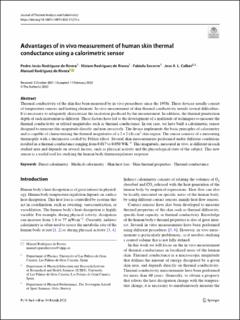| dc.contributor.author | Rodríguez de Rivera, Pedro Jesús | |
| dc.contributor.author | Rodríguez de Rivera, Miriam | |
| dc.contributor.author | Socorro, Fabiola | |
| dc.contributor.author | Calbet, Jose Antonio Lopez | |
| dc.contributor.author | Rodríguez de Rivera, Manuel | |
| dc.date.accessioned | 2022-06-30T11:55:34Z | |
| dc.date.available | 2022-06-30T11:55:34Z | |
| dc.date.created | 2022-04-02T13:51:21Z | |
| dc.date.issued | 2022 | |
| dc.identifier.citation | Journal of Thermal Analysis and Calorimetry. 2022, Artikkel 11275-x. | en_US |
| dc.identifier.issn | 1388-6150 | |
| dc.identifier.uri | https://hdl.handle.net/11250/3001774 | |
| dc.description | This article is licensed under a Creative Commons Attribution 4.0 International License, which permits use, sharing, adaptation, distribution and reproduction in any medium or format, as long as you give appropriate credit to the original author(s) and the source, provide a link to the Creative Commons license, and indicate if changes were made. The images or other third party material in this article are included in the article’s Creative Commons license, unless indicated otherwise in a credit line to the material. If material is not included in the article’s Creative Commons license and your intended use is not permitted by statutory regulation or exceeds the permitted use, you will need to obtain permission directly from the copyright holder. | en_US |
| dc.description.abstract | Thermal conductivity of the skin has been measured by in vivo procedures since the 1950s. These devices usually consist of temperature sensors and heating elements. In vivo measurement of skin thermal conductivity entails several difficulties. It is necessary to adequately characterize the excitation produced by the measurement. In addition, the thermal penetration depth of each instrument is different. These factors have led to the development of a multitude of techniques to measure the thermal conductivity or related magnitudes such as thermal conductance. In our case, we have built a calorimetric sensor designed to measure this magnitude directly and non-invasively. The device implements the basic principles of calorimetry and is capable of characterizing the thermal magnitudes of a 2 × 2 (4) cm2 skin region. The sensor consists of a measuring thermopile with a thermostat cooled by Peltier effect. Several skin measurements performed under different conditions resulted in a thermal conductance ranging from 0.017 to 0.050 WK−1. This magnitude, measured in vivo, is different in each studied area and depends on several factors, such as physical activity and the physiological state of the subject. This new sensor is a useful tool for studying the human body thermoregulatory response. | en_US |
| dc.language.iso | eng | en_US |
| dc.subject | direct calorimetry | en_US |
| dc.subject | medical calorimetry | en_US |
| dc.subject | skin heat loss | en_US |
| dc.subject | skin thermal properties | en_US |
| dc.subject | thermal conductance | en_US |
| dc.title | Advantages of in vivo measurement of human skin thermal conductance using a calorimetric sensor | en_US |
| dc.type | Peer reviewed | en_US |
| dc.type | Journal article | en_US |
| dc.description.version | publishedVersion | en_US |
| dc.rights.holder | © The Author(s) 2022 | en_US |
| dc.source.pagenumber | 10 | en_US |
| dc.source.journal | Journal of Thermal Analysis and Calorimetry | en_US |
| dc.identifier.doi | 10.1007/s10973-022-11275-x | |
| dc.identifier.cristin | 2014798 | |
| dc.description.localcode | Institutt for fysisk prestasjonsevne / Department of Physical Performance | en_US |
| dc.source.articlenumber | 11275-x | en_US |
| cristin.ispublished | true | |
| cristin.fulltext | original | |
| cristin.qualitycode | 1 | |
